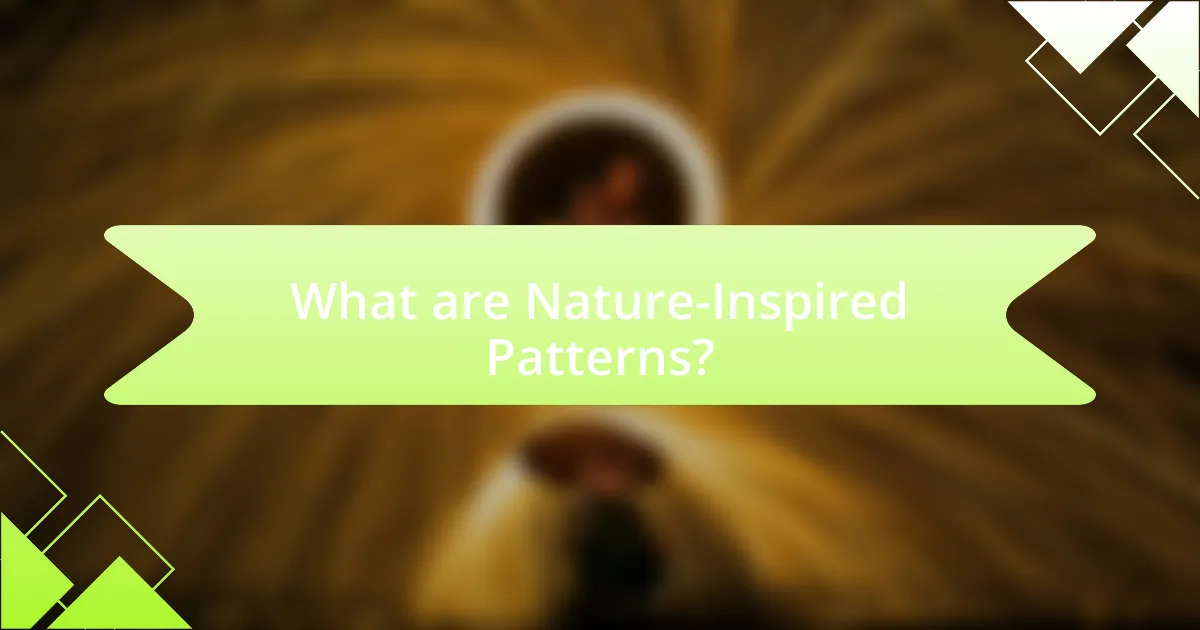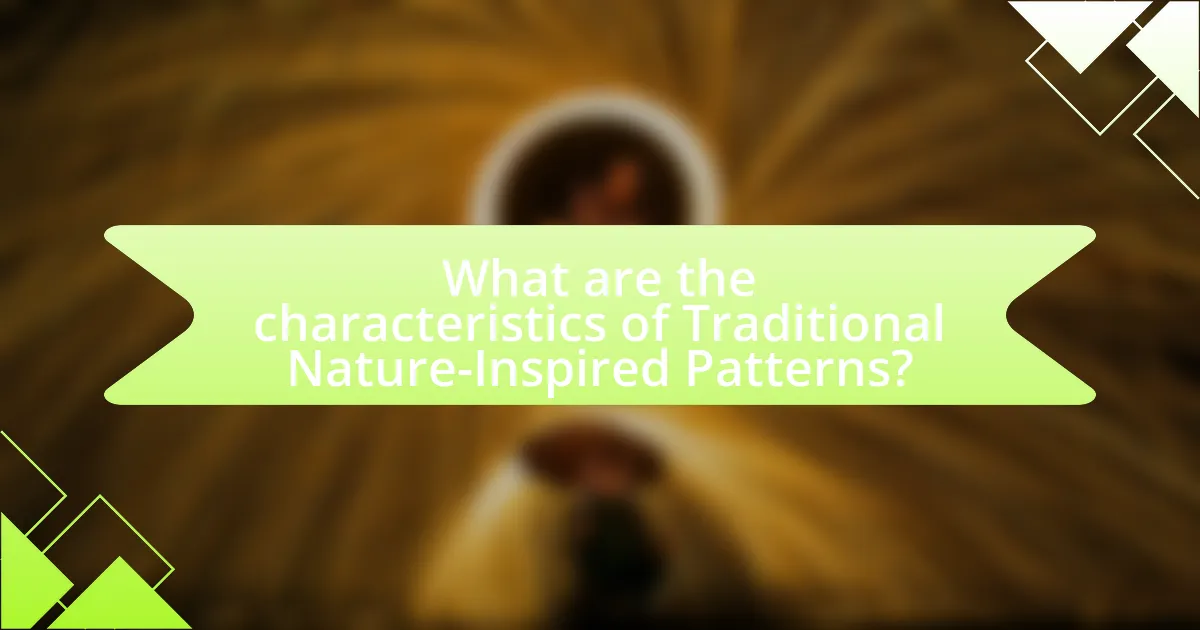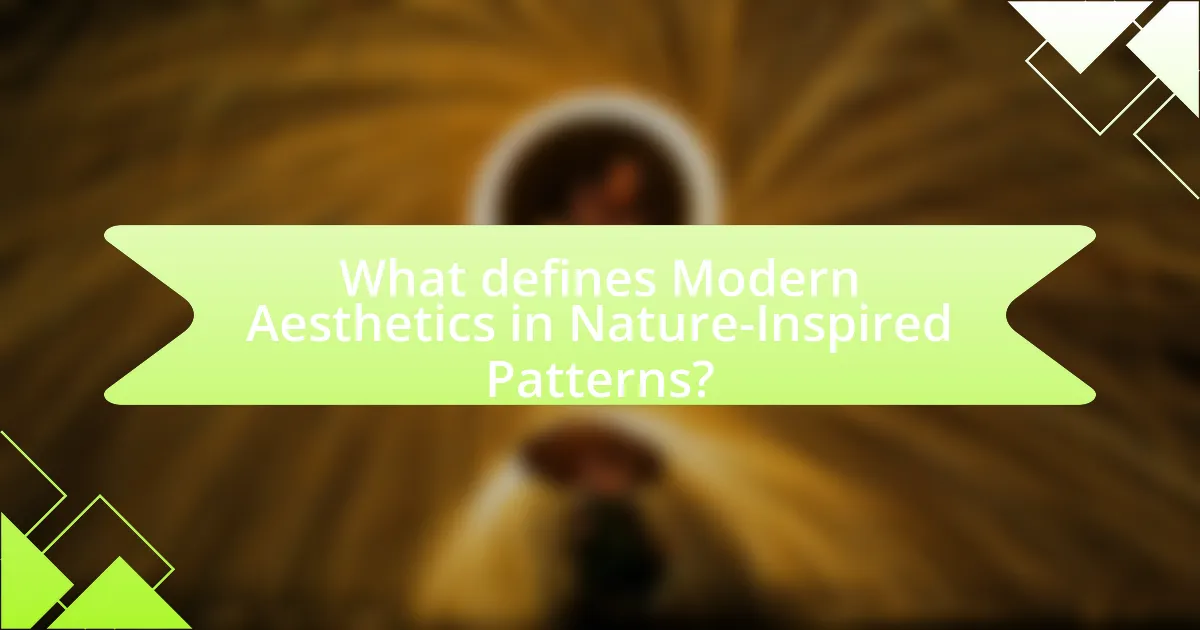Nature-inspired patterns are designs that reflect the forms, colors, and structures found in nature, often incorporating elements like leaves, flowers, and landscapes. The article explores the evolution of these patterns from traditional motifs rooted in cultural symbolism to contemporary designs influenced by modern aesthetics and technology. It examines historical influences, cultural contexts, and the emotional responses these patterns evoke, highlighting their significance in art and design. Additionally, the article discusses the characteristics of traditional patterns, the impact of sustainability on modern designs, and practical applications in various fields, including architecture and branding.

What are Nature-Inspired Patterns?
Nature-inspired patterns are designs that draw directly from the forms, colors, and structures found in nature. These patterns often mimic elements such as leaves, flowers, animal textures, and natural landscapes, reflecting the organic beauty and complexity of the natural world. Research indicates that nature-inspired designs can enhance aesthetic appeal and evoke emotional responses, as seen in studies on biophilic design, which emphasizes the human connection to nature.
How have Nature-Inspired Patterns evolved over time?
Nature-inspired patterns have evolved significantly over time, transitioning from traditional motifs rooted in cultural symbolism to contemporary designs influenced by modern aesthetics and technology. Historically, ancient civilizations, such as the Egyptians and Greeks, utilized nature-inspired patterns to convey spiritual beliefs and societal values, often incorporating elements like flora and fauna into their art and architecture.
In the 19th century, the Arts and Crafts Movement emphasized handcrafted designs that celebrated natural forms, leading to a resurgence of interest in organic patterns. The introduction of new materials and printing techniques in the 20th century further transformed these patterns, allowing for greater experimentation and abstraction.
Today, digital technology enables designers to create intricate, nature-inspired patterns that blend realism with abstraction, reflecting a broader range of influences, including environmental concerns and biomimicry. This evolution illustrates a continuous dialogue between nature and human creativity, adapting to cultural shifts and technological advancements.
What historical influences shaped traditional nature-inspired designs?
Traditional nature-inspired designs have been shaped by various historical influences, including cultural symbolism, artistic movements, and regional craftsmanship. For instance, the Arts and Crafts Movement in the late 19th century emphasized a return to handcrafted goods and drew inspiration from natural forms, promoting the idea that art should reflect the beauty of nature. Additionally, ancient civilizations, such as the Egyptians and Greeks, incorporated motifs from their natural surroundings into their art and architecture, establishing a long-standing tradition of nature-inspired aesthetics. The use of floral and fauna patterns in textiles and ceramics can be traced back to these early influences, demonstrating how historical contexts have consistently informed the design principles that celebrate the natural world.
How did cultural contexts impact the interpretation of these patterns?
Cultural contexts significantly influenced the interpretation of nature-inspired patterns by shaping aesthetic values and symbolic meanings associated with these designs. For instance, in traditional Japanese art, nature patterns often reflect seasonal changes and are imbued with spiritual significance, as seen in the use of cherry blossoms to symbolize the transient nature of life. In contrast, modern interpretations in Western design may prioritize abstraction and minimalism, focusing on the visual impact rather than cultural symbolism. This divergence illustrates how cultural backgrounds dictate the lens through which patterns are understood, with specific historical and social contexts informing the meanings attributed to these designs.
Why are Nature-Inspired Patterns significant in art and design?
Nature-inspired patterns are significant in art and design because they reflect the intrinsic beauty and complexity of the natural world, fostering a connection between humans and their environment. These patterns often embody principles of symmetry, balance, and organic forms, which are visually appealing and evoke emotional responses. Research indicates that incorporating nature-inspired designs can enhance creativity and well-being; for instance, a study published in the Journal of Environmental Psychology found that exposure to nature-related imagery can improve mood and cognitive function. Thus, the integration of nature-inspired patterns in art and design not only enriches aesthetic value but also promotes psychological benefits.
What emotional responses do these patterns evoke in viewers?
Nature-inspired patterns evoke feelings of tranquility, nostalgia, and connection to the environment in viewers. These patterns often reflect organic forms and natural elements, which can trigger a sense of calmness and relaxation, as supported by studies indicating that exposure to nature can reduce stress and anxiety levels. Additionally, traditional designs may evoke nostalgia, reminding viewers of cultural heritage and personal memories associated with nature. This emotional response is reinforced by psychological research showing that familiarity with natural motifs can enhance emotional well-being and foster a sense of belonging.
How do these patterns reflect the relationship between humans and nature?
Nature-inspired patterns reflect the relationship between humans and nature by illustrating how human creativity draws from natural forms and processes. These patterns often mimic organic shapes, colors, and textures found in the environment, demonstrating an intrinsic connection to the natural world. For instance, traditional art forms like Japanese kimono designs incorporate floral motifs that celebrate seasonal changes, while modern design often utilizes biomimicry, where structures are inspired by natural systems for efficiency and sustainability. This ongoing dialogue between human expression and the natural environment highlights a mutual influence, where nature serves as both a source of inspiration and a framework for sustainable practices.

What are the characteristics of Traditional Nature-Inspired Patterns?
Traditional nature-inspired patterns are characterized by their organic forms, intricate details, and harmonious color palettes that reflect the natural world. These patterns often incorporate motifs such as leaves, flowers, animals, and landscapes, emphasizing symmetry and balance. Historically, cultures around the world, including Japanese, Islamic, and Native American, have utilized these designs in textiles, ceramics, and architecture, showcasing a deep connection to nature and spirituality. The use of repetitive elements and flowing lines in these patterns serves to evoke a sense of tranquility and unity with the environment, reinforcing their significance in traditional art forms.
What materials and techniques were commonly used in traditional designs?
Traditional designs commonly utilized natural materials such as wood, clay, stone, and textiles, along with techniques like hand weaving, carving, and pottery. For instance, wood was often carved into intricate patterns, while clay was shaped and fired to create functional and decorative pottery. Textiles were typically hand-woven using techniques passed down through generations, reflecting cultural motifs and nature-inspired patterns. These materials and techniques not only served practical purposes but also embodied the aesthetic values and cultural narratives of the communities that produced them.
How do natural elements influence the choice of colors and shapes?
Natural elements significantly influence the choice of colors and shapes by providing a diverse palette and form inspired by the environment. For instance, the colors found in flora and fauna, such as the vibrant greens of leaves or the deep blues of oceans, directly inform design choices in various fields, including fashion and interior design. Additionally, shapes derived from natural forms, like the curves of a leaf or the angularity of mountains, are often replicated in architecture and product design. Research indicates that designs mimicking nature can enhance aesthetic appeal and user experience, as seen in studies by Kaplan and Kaplan (1989) which highlight the psychological benefits of nature-inspired aesthetics.
What are some examples of traditional patterns from different cultures?
Traditional patterns from different cultures include the following:
- Japanese Seigaiha – This wave pattern symbolizes the ocean and is often used in textiles and ceramics.
- Native American Navajo Patterns – Characterized by geometric shapes and vibrant colors, these patterns reflect the natural landscape and cultural stories.
- Indian Paisley – Known as “boteh,” this teardrop-shaped motif represents fertility and is commonly found in textiles.
- African Kente Cloth – Originating from Ghana, Kente features bright colors and intricate designs that convey proverbs and historical narratives.
- Scottish Tartan – This checked pattern represents different clans and is traditionally woven into wool fabric.
These patterns are deeply rooted in their respective cultures, often carrying significant meanings and historical context.
How do traditional patterns differ across various cultures?
Traditional patterns differ across various cultures primarily in their motifs, colors, and symbolic meanings. For instance, Native American patterns often incorporate geometric shapes and nature-inspired elements, reflecting their connection to the land and spirituality. In contrast, African textiles frequently feature vibrant colors and intricate designs that convey social status and cultural identity. Asian cultures, such as Japanese, utilize patterns like Seigaiha (waves) and Asanoha (hemp leaves), which symbolize prosperity and resilience. These differences are rooted in each culture’s history, environment, and social structures, showcasing how traditional patterns serve as a visual language that communicates cultural values and beliefs.
What role does symbolism play in traditional nature-inspired designs?
Symbolism plays a crucial role in traditional nature-inspired designs by conveying deeper meanings and cultural narratives through visual elements. For instance, motifs such as leaves, flowers, and animals often represent specific virtues or beliefs; for example, the lotus flower symbolizes purity and enlightenment in many Asian cultures. These symbols not only enhance the aesthetic appeal of the designs but also serve as a means of storytelling, reflecting the values and philosophies of the societies that create them. Historical evidence shows that various cultures have utilized these symbols to communicate their relationship with nature, spirituality, and identity, thereby reinforcing the significance of symbolism in traditional art forms.
How do regional flora and fauna influence pattern creation?
Regional flora and fauna significantly influence pattern creation by providing diverse shapes, colors, and textures that artists and designers draw upon. For instance, the intricate patterns found in the leaves of tropical plants or the unique markings of local wildlife often inspire textile designs and architectural motifs. Studies have shown that traditional crafts, such as Japanese kimono patterns, are directly inspired by local flora like cherry blossoms and fauna such as cranes, reflecting the natural environment’s aesthetic. This connection between nature and design not only enhances visual appeal but also fosters cultural identity, as seen in indigenous art forms that incorporate local species into their patterns.

What defines Modern Aesthetics in Nature-Inspired Patterns?
Modern aesthetics in nature-inspired patterns are defined by their emphasis on minimalism, abstraction, and organic forms that reflect natural elements. This approach often incorporates geometric shapes, fluid lines, and a muted color palette, creating a harmonious balance between nature and contemporary design. For instance, the use of botanical motifs in a simplified, stylized manner exemplifies this trend, as seen in the works of designers like Marimekko, who blend traditional floral designs with modern graphic techniques. The integration of sustainable materials further reinforces this aesthetic, aligning with contemporary values of environmental consciousness and innovation.
How have contemporary artists reinterpreted traditional patterns?
Contemporary artists have reinterpreted traditional patterns by integrating modern techniques and materials while maintaining the essence of the original designs. For instance, artists like El Anatsui and Takashi Murakami blend traditional motifs with contemporary themes, using unconventional materials such as recycled bottle caps and vibrant colors to create new visual narratives. This approach not only honors the cultural significance of traditional patterns but also makes them relevant in today’s context, as seen in the resurgence of interest in indigenous art forms and their adaptation into modern design.
What new materials and technologies are being utilized in modern designs?
Modern designs utilize advanced materials such as bioplastics, carbon fiber, and smart textiles, alongside technologies like 3D printing and augmented reality. Bioplastics, derived from renewable sources, reduce environmental impact while maintaining functionality. Carbon fiber offers high strength-to-weight ratios, making it ideal for lightweight structures. Smart textiles incorporate sensors and electronics, enabling interactive and responsive designs. 3D printing allows for rapid prototyping and complex geometries, facilitating innovative forms. Augmented reality enhances design visualization, enabling users to interact with designs in real-time. These materials and technologies collectively push the boundaries of creativity and sustainability in modern design.
How does minimalism influence modern nature-inspired aesthetics?
Minimalism significantly influences modern nature-inspired aesthetics by emphasizing simplicity and the essential qualities of natural forms. This design philosophy strips away unnecessary elements, allowing the beauty of nature to be highlighted through clean lines, open spaces, and a limited color palette that often reflects natural hues. For instance, contemporary architecture frequently incorporates large windows and natural materials, creating a seamless connection between indoor and outdoor environments, which aligns with minimalist principles. The integration of these elements not only enhances the visual appeal but also promotes a sense of tranquility and mindfulness, as seen in the works of designers like Tadao Ando, who utilizes minimalism to evoke a deeper appreciation for nature.
What trends are emerging in modern nature-inspired design?
Emerging trends in modern nature-inspired design include biophilic design, sustainable materials, and organic forms. Biophilic design emphasizes the integration of natural elements into built environments, enhancing well-being and productivity, as supported by studies indicating that exposure to nature reduces stress and improves cognitive function. The use of sustainable materials, such as reclaimed wood and recycled metals, reflects a growing awareness of environmental impact, with the global green building market projected to reach $364.6 billion by 2022. Additionally, organic forms inspired by natural shapes and patterns are increasingly prevalent in architecture and product design, promoting a sense of harmony with the environment.
How are sustainability and eco-consciousness shaping modern patterns?
Sustainability and eco-consciousness are significantly shaping modern patterns by driving the adoption of environmentally friendly materials and design practices. Designers increasingly prioritize sustainable resources, such as organic textiles and recycled materials, to reduce environmental impact. For instance, the global market for sustainable fashion is projected to reach $8.25 billion by 2023, reflecting a growing consumer demand for eco-friendly products. Additionally, eco-conscious design principles encourage patterns that mimic natural forms and processes, promoting a harmonious relationship with the environment. This shift not only influences aesthetic choices but also fosters a broader cultural movement towards sustainability, as seen in initiatives like the Fashion for Good program, which supports innovations in sustainable fashion.
What role does digital art play in the evolution of these patterns?
Digital art significantly influences the evolution of nature-inspired patterns by enabling innovative techniques and broader accessibility. Through software tools, artists can manipulate and create intricate designs that reflect natural forms, enhancing traditional aesthetics with modern technology. For instance, algorithms can generate fractal patterns that mimic organic structures, showcasing the intersection of nature and digital creativity. This evolution is evidenced by the rise of digital platforms where artists share their work, leading to a global exchange of ideas and styles, thus accelerating the transformation of traditional patterns into contemporary interpretations.
What practical applications do Nature-Inspired Patterns have today?
Nature-inspired patterns have practical applications in various fields today, including architecture, product design, and textiles. In architecture, biomimicry is utilized to create energy-efficient buildings that mimic natural forms, such as the Eden Project in the UK, which uses geodesic domes inspired by natural structures. In product design, companies like Nike incorporate patterns found in nature to enhance functionality and aesthetics, as seen in their use of hexagonal patterns for improved grip in footwear. In textiles, designers employ nature-inspired motifs to create sustainable fabrics, often using organic dyes derived from plants, which aligns with eco-friendly practices. These applications demonstrate the versatility and relevance of nature-inspired patterns in contemporary design and sustainability efforts.
How can these patterns be integrated into interior design?
Nature-inspired patterns can be integrated into interior design through the use of textiles, wall art, and decorative elements that reflect natural forms and colors. For instance, incorporating botanical prints in upholstery or curtains can create a cohesive theme that connects indoor spaces with the outdoors. Additionally, using wallpapers featuring floral or leaf motifs can enhance the aesthetic appeal of a room while promoting a sense of tranquility. Research indicates that nature-inspired designs can improve well-being and reduce stress, as evidenced by studies showing that environments reflecting natural elements contribute to enhanced mood and productivity.
What are the benefits of using nature-inspired patterns in branding?
Using nature-inspired patterns in branding enhances visual appeal, fosters emotional connections, and promotes sustainability. These patterns resonate with consumers by evoking feelings of tranquility and authenticity, which can lead to increased brand loyalty. Research indicates that brands incorporating natural elements can improve customer perception; for instance, a study published in the Journal of Environmental Psychology found that nature-themed designs can enhance positive emotions and brand trust. Additionally, aligning with eco-friendly values through nature-inspired branding can attract environmentally conscious consumers, further solidifying a brand’s market position.
